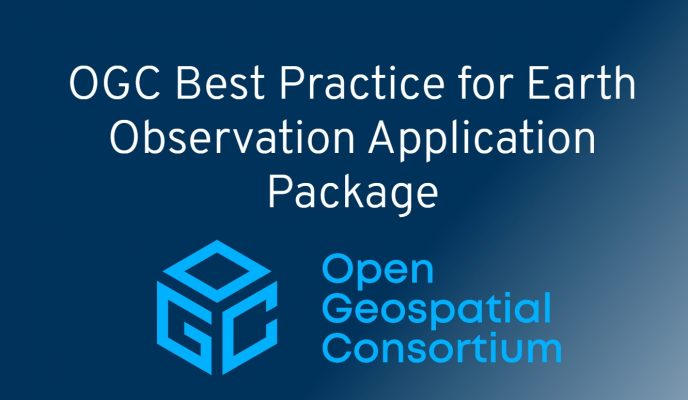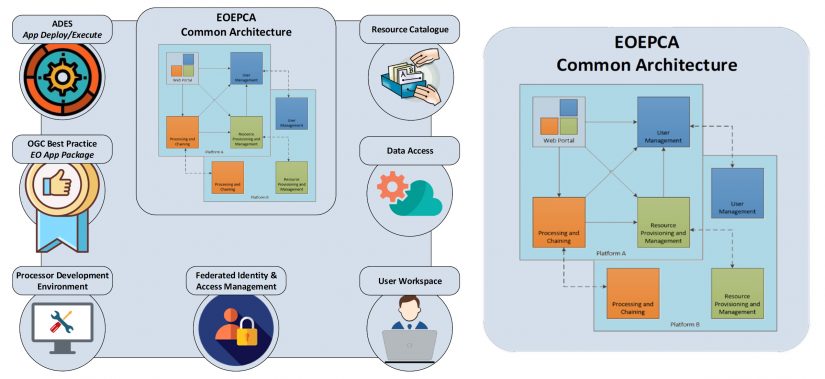Availability of vast volumes of space-based EO data on cloud environments is a growing trend that enables the science and value-adding communities to perform processing conveniently and at large scale without going through the cumbersome burden of data downloading. Many cloud platforms provide immediate access to data preparation processors as well.
The advanced processing environments, readily available tools and easy-to-use interfaces offering attract the users and tie them to specific platforms, generating a “lock-in” situation. Moving to a different cloud provider / platform may in fact require numerous expensive adaptations of the user applications, sometimes resulting in a prohibitive effort.
On the other hand, there can be many good reasons to change the cloud provider or perhaps use several cloud providers for a specific application: e.g. cost of processing infrastructure, more favourable collaboration model, availability of data, cloud infrastructure constraints for the final recipient of the processing outcomes.
Working for common good
Over the past year, ESA, in collaboration with NASA, Natural Resources Canada and a set of expert industrial providers, have been analysing possible solutions in the OGC (Open Geospatial Consortium) framework, where standards and best practices for the benefit of the geospatial community are defined. A dedicated EO Exploitation Platform Domain Working Group has been created to drive the change on such a high-interest topic.
ESA contributed to various OGC testbeds and pilots (starting from testbed-13 in 2018), as part of the EO Exploitation Platform Common Architecture (EOEPCA) programmatic activities.
Such in-depth practical experience paved the way to define best practices in setting up cloud environments and in coding applications that can be dynamically deployed on various cloud infrastructures (bring the user/application to the data paradigm).
Scrutinised and approved by the EO Exploitation Platform Domain Working Group, the OGC Technical Committee and the OGC Planning Committee, the Best Practice for Earth Observation Application Package [OGC 20-089r1] has been released. It includes guidelines – based on the use of the Docker industrial standard and a set of suitable OGC APIs – to develop easily deployable applications for cloud environments aligned to provided indications.
Supporting the guidelines exploitation
ESA is taking a number of actions to streamline use of the defined guidelines.
An open source platform-out-of-the-box has been made available through the EOEPCA: it can easily be deployed on any cloud providing a Kubernetes environment, also known as the “operating system of the clouds”. Learn more about this from the Φ-week 2021 presentations.
EOEPCA platform-out-of-the-box allows platform operators to deploy an OGC-compliant platform to host and share applications. It comprises the following components:
The open source platform can be easily deployed using helm chart packages and all necessary support by the open source team is ensured by ESA. An introductory presentation gives an overview of the components that can be deployed.
The Application Deployment and Execution Service (ADES) is the minimum mandatory environment to make the infrastructure interoperable, allowing deployment and execution of applications.
In 2022 ESA intends to perform the roll-out of this interoperability layer by two independent platform operators – TerraDue and Space Application Services – who will operate their Algorithm Hosting services on multiple clouds of the Network of Resources. By using these services to host an application, it’s guaranteed that it can be easily executed on different cloud environments.
Take your chance
- Ask for NoR Sponsorship to use these services free-at-point-of-use. Further support will be given to additional infrastructure and platform operators to migrate to this new state-of-the-art of cloud-based platform interoperability as part of the EOEPCA open ITT.
- Are you running an EO application project? The EOEPCA team can also support you as use case to set up your own interoperable project platform, to help you manage all project resources, facilitate execution at scale of your applications, and ensure that your applications are compliant with the OGC interoperability best practices.
- Are you interested in the interoperability topic? Consider joining the OGC Exploitation Platform Domain Working Group WG to stay at the forefront of technological innovation or contact us for further inquiries.



